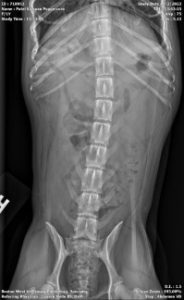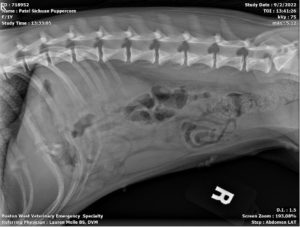Case Study: Sichuan Puppercorn & Her Foreign Body

Sichuan Puppercorn is a 1 year 6-month-old spayed female Corgi who was presented to the Boston West ER for ingestion of a plastic piece on her inflatable e-collar. Sichuan Puppercorn had recently undergone a spay surgery with her primary care veterinarian and was wearing the e-collar to prevent her from licking her spay incision. She was able to get to the plastic plug and ingested it sometime overnight. She vomited that morning and seemed uncomfortable.
History & Physical Examination
On presentation, Sichuan Puppercorn was very energetic! She was a little nervous, but her vitals were normal (heart rate, respiratory rate, and temperature). She was slightly nauseous when her abdomen was palpated. Her spay incision appeared to be healing well and was non-painful.
Diagnosis & Clinical Signs
Concern for the plastic piece she ingested potentially causing an obstruction in the stomach or small intestines was discussed. It was recommended to try to induce vomiting to see if she would bring up the piece. Even though she had vomited at home, inducing vomiting can sometimes result in a more forceful emesis.
Treatment
Vomiting was induced with an injectable medication called Apomorphine. Apomorphine is primarily used as an emetic in dogs (it doesn’t work in cats!). The side effect can be sedation immediately following administration, but generally these symptoms resolve in a few hours. Inducing vomiting can generally remove up to 80% of stomach contents, but it is not always this effective and often further monitoring or treatment is needed depending on what the pet ingested.
Some owners will try inducing vomiting at home with hydrogen peroxide. Owners are often cautioned against doing so due to risk of aspiration, choking, and development of gastric irritation. While some of these risks are still a factor when inducing vomiting in a hospital setting, it is done in a controlled environment with medical professionals monitoring in case any complications arise.
Sichuan Puppercorn received a dose of Apomorphine, and we were successful in inducing vomiting, but no plastic piece! It was then recommended to take an x-ray to see if we could see the plastic piece in his stomach (see image below).


The plastic piece was still noted to be in the stomach on x-ray. It was decided to try to induce vomiting again, this time after feeding a small meal in the hospital which she ate readily! Vomiting was again induced, and the plastic piece was retrieved. She received an injection of anti-nausea medication and was discharged.
Outcome
Sichuan Puppercorn has been doing very well at home since her visit and has had no further vomiting. If she had not vomited the piece of plastic, then sometimes referral for endoscopy is needed where a camera is used to try to locate the object in the stomach and retrieve it. This can be a less invasive procedure over surgery but has its limitations depending on the object ingested. Luckily, Sichuan Puppercorn and her mom were able to avoid this!

Sichuan Puppercorn (left) and her brother (right)
References:
Niedzwecki AH, Book BP, Lewis KM, Estep JS, Hagan J. Effects of oral 3% hydrogen peroxide used as an emetic on the gastroduodenal mucosa of healthy dogs. J Vet Emerg Crit Care (San Antonio). 2017 Mar;27(2):178-184. doi: 10.1111/vec.12558. Epub 2016 Dec 14. PMID: 27973761.
Plumbs Veterinary Drug Handbook